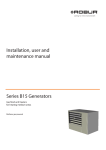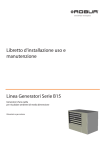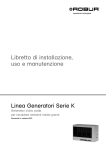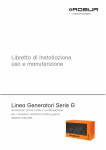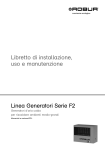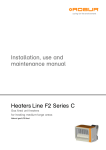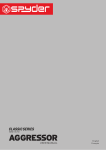Download Installation, use and maintenance manual Heaters Line
Transcript
Installation, use and
maintenance manual
Heaters Line B15 Series
Gas fired unit heaters
for heating medium areas
Natural gas fired
Revision: D
Code: D-LBR595
This manual has been drawn up and printed by Robur S.p.A.; whole or partial reproduction of this manual is
prohibited.
The original is filed at Robur S.p.A.
Any use of this manual other than for personal consultation must be previously authorised by Robur S.p.A.
The rights of those who have legitimately filed the registered trademarks contained within this publication are not
affected.
With the aim of continuously improving the quality of its products, Robur S.p.A. reserves the right to modify the
data and contents of this manual without prior notice.
INDEX OF CONTENTS
1PREFACE�������������������������������������������������������������������������������������������������������������������������������������������������� 4
2OVERVIEW AND TECHNICAL FEATURES���������������������������������������������������������������������������������������������� 5
2.1WARNINGS���������������������������������������������������������������������������������������������������������������������������������������������������������������������������������������������������������������������5
2.2NOTES ON OPERATION OF THE APPLIANCE������������������������������������������������������������������������������������������������������������������������������������������������������5
2.3TECHNICAL MANUFACTURING CHARACTERISTICS�����������������������������������������������������������������������������������������������������������������������������������������6
2.4TECHNICAL DATA��������������������������������������������������������������������������������������������������������������������������������������������������������������������������������������������������������7
2.5DIMENSIONS�����������������������������������������������������������������������������������������������������������������������������������������������������������������������������������������������������������������8
3INSTALLATION���������������������������������������������������������������������������������������������������������������������������������������� 9
3.1GENERAL INSTALLATION INSTRUCTIONS�����������������������������������������������������������������������������������������������������������������������������������������������������������9
3.2SIZING AND INSTALLING THE COMBUSTION AIR/FUMES EXHAUST TUBES���������������������������������������������������������������������������������������� 11
3.3BRACKET INSTALLATION���������������������������������������������������������������������������������������������������������������������������������������������������������������������������������������� 14
3.4INSTALLING THE WALL PANEL������������������������������������������������������������������������������������������������������������������������������������������������������������������������������ 15
3.5SETTING THE GAS VALVE��������������������������������������������������������������������������������������������������������������������������������������������������������������������������������������� 16
3.6WIRING DIAGRAMS�������������������������������������������������������������������������������������������������������������������������������������������������������������������������������������������������� 18
4USE AND OPERATION�������������������������������������������������������������������������������������������������������������������������� 22
4.1SWITCHING ON AND SWITCHING OFF�������������������������������������������������������������������������������������������������������������������������������������������������������������� 22
5SERVICE AND ASSISTANCE����������������������������������������������������������������������������������������������������������������� 24
5.1MALFUNCTIONS������������������������������������������������������������������������������������������������������������������������������������������������������������������������������������������������������� 24
5.2CLEANING THE REMOVABLE BURNER��������������������������������������������������������������������������������������������������������������������������������������������������������������� 24
Installation, use and maintenance manual – Heaters Line B15 Series
3
1 PREFACE
1 PREFACE
The present "Installation, use and maintenance manual" is intended for anyone who is to install or operate Robur series B15 hot air
generators.
In particular, the booklet is intended for the plumber who will install the generator, the electrician who will connect it to the mains
power supply and the final user who will control it during everyday operation.
The booklet is also intended for technical service staff charged with the main service tasks.
Summary
The booklet has 5 sections:
SECTION 1 is a brief introduction to the use of the manual itself
SECTION 2 is intended for use by the final user, hydraulic and electrical installation technicians and the service technician; it gives
general warnings, operating instructions and constructional specifications for the B15 series.
SECTION 3 is intended for use by the hydraulic and electrical installation technicians; it provides the information required to install
series B15 generators correctly.
SECTION 4 is intended for use by the final user; it provides the information required to operate series B15 generators correctly.
SECTION 5 is intended for use by technical service technicians; it provides the information required to adjust the gas flow and run
gas type changeovers. It also includes service instructions.
The icons used in the manual have the following meanings:
= DANGER
= WARNING
= NOTE
= START OF OPERATING PROCEDURE
= REFERENCE to another part of the manual or other document
4
2 OVERVIEW AND TECHNICAL FEATURES
2 OVERVIEW AND TECHNICAL FEATURES
This section contains general instructions regarding the installation and operation of series B15 generators, and a brief section about
the operation of generators, their construction and technical data.
2.1 WARNINGS
This manual constitutes an integral and essential part of the product and must be delivered to the user together with the appliance.
The appliance must only be used for the purposes for which it has been designed. Any other use must be considered inappropriate
and therefore dangerous.
The appliance is not intended to be used by persons (including children) whose physical, sensory and mental capacities
are impaired, or who lack the necessary experience and knowledge, unless they are supervised or instructed in its use by
persons responsible for their safety. Children must be supervised to ensure that they do not play with the appliance.
The manufacturer is exempt from any contractual or extra-contractual responsibility for damage caused by errors of installation, use
and in any case the non-observance of the instructions supplied by the manufacturer.
The appliance must be installed in accordance with established legislation.
Do not obstruct the fan intake or the outlet grilles.
In the event of failure of the appliance and/or breakage of any of its parts, deactivate it by disconnecting it from the electrical and gas supplies, and refrain from any attempt to repair and/or restore operation of the appliance through direct action.
Any repair may be carried out solely by a ROBUR Technical Assistance Centre, using only original replacement parts.
The non-observance of the foregoing warnings may compromise the safety of the device.
For correct operation, the appliance must be overhauled annually as per the manufacturer’s instructions, by professionally qualified service personnel.
.
,
“Professionally qualified personnel” is defined as those possessing specific technical competence in the residential heating
equipment sector. Contact ROBUR S.p.A. Technical Assistance Centre (tel. +39.035.888.111) for any further information.
If the appliance is put out of service for a long time, refer to paragraph 4.1 p. 22.
If the appliance is to be sold or transferred to another owner, ensure that this booklet is handed over to the new owner and installation technician for their reference.
Before starting up the generator, have the following items checked by professionally qualified personnel :
▶▶ the electricity and gas mains specifications correspond to the specifications on the nameplate;
▶▶
the fumes exhaust tubes are operational;
▶▶
the combustion air and fumes exhaust are in accordance with established legislation;
▶▶
the gas supply seals, both internal and external;
▶▶
the gas flow rate setting as required by the generator’s power rating;
▶▶
the gas supplied to the appliance is of the type for which it is designed;
▶▶
the gas supply pressure in relation to the admitted range specified on the nameplate;
▶▶
t he gas supply system is correctly rated for the capacity required by the appliance, and that it is equipped with all safety and
control devices prescribed by current regulations.
Do not use gas pipes to ground electrical appliances.
IF YOU SMELL GAS:
▶▶
Do not operate electrical switches, the phone or any other equipment which may generate sparks.
▶▶
Immediately open the doors and windows to allow fresh air to enter the area.
▶▶
Close the gas valve.
▶▶
Contact professionally qualified personnel for assistance.
2.2 NOTES ON OPERATION OF THE APPLIANCE
The series B15 hot air generator is an independent heating appliance with sealed circuit and forced draw.
The appliance can be used with natural gas (G20).
It is designed for installation inside the room to be heated.
The combustion circuit is sealed in relation to the room and corresponds to the requirements of EN 1020 for type C appliances: the
combustion air intake and fumes exhaust are outdoors and are driven by a blower in the combustion circuit.
The appliance is homologated as type B for installations in which the combustion air is drawn directly from the room itself.
The generator is controlled by a room thermostat (not supplied). When the thermostat trips, the controller waits for a pre-plunge
delay of around 40 seconds, and then ignites the burner.
The detection electrode senses the flame. If it fails to detect a flame, the controller locks out the appliance.
Installation, use and maintenance manual – Heaters Line B15 Series
5
2 OVERVIEW AND TECHNICAL FEATURES
Combustion products are sent through the heat exchangers which are subject to an external flow of air from the fan, thus delivering
hot air to the room.
The flow of air can be adjusted vertically with the horizontal fins of the delivery grille. On request, a vertical fins kit is available to enable the direction of the flow of air to be adjusted horizontally.
If the heat exchangers overheat due to a malfunction, a limit thermostat trips and shuts off power to the gas valve, which in turn cuts
off the supply of gas to the burner. The generator must be reset manually once the limit thermostat has tripped, using the remote
control.
A blower upline of the burner mixes the air and gas and expels the combustion fumes.
The generator can run in HEATING mode (WINTER mode) and also provides a pleasant flow of fresh air during the summer in FAN
ONLY mode (SUMMER mode). For further information see paragraph "4.1 p. 22".
2.3 TECHNICAL MANUFACTURING CHARACTERISTICS
Series B15 hot air generators are supplied complete with:
▶▶ pre-mix burner in stainless steel.
▶▶
high head blower.
▶▶
cylindrical combustion chamber in stainless steel.
▶▶
heat exchangers in corrugated stainless steel with a very large exchange surface.
▶▶
external panelling in steel with epoxy powder enamel finish.
▶▶
high capacity axial fan.
▶▶
CONTROL AND SAFETY COMPONENTS:
▶▶
▶▶
▶▶
controller board, with CPU: controls burner ignition, flame detection; blower speed control, fan speed control.
▶▶
Power voltage: 230 V - 50 Hz.
▶▶
Safety time: 5 seconds.
▶▶
Pre-plunge time: 5 seconds.
▶▶
Model: Bertelli & Partners DIMS05 with ignition transformer.
limit thermostat set to 100°C, automatic reset, to prevent heat exchanger overheating.
Gas solenoid valve: if a safety device trips (limit thermostat) the gas valve is de-excited, thus cutting off gas supply to
the burner.
▶▶
Power voltage: 230 V - 50 Hz.
▶▶
Operating temperature: 0° C to +60° C.
▶▶
Model: SIT 830 Tandem / BM 762.
Figure 2.1
LEGEND
A
B
C
D
E
E
D
C
A
Electrical panel.
6
B
t ransformer 230/24 V AC
ignition transformer
t erminal block with fuse
limit thermostat
c ontroller
2 OVERVIEW AND TECHNICAL FEATURES
2.4 TECHNICAL DATA
Table 2.1 – Technical data.
TECHNICAL CHARACTERISTICS
unit of measurement
B15
appliance category
I2H
appliance category (Germany)
I2ELL
appliance category (Poland)
I2ELwLs
appliance type
gas
thermal capacity
thermal power
gas consumption (1)
efficiency
gas supply pressure
gas fitting dia.
fumes/combustion air fitting dia.
electrical power
electrical power absorption
fuse
operating temperature (2)
air flow (3)
thermal differential
air throw (4)
sound level at 6 m
sound level at 6 m
weight
natural (methane)
nominal
nominal
natural (G20)
nominal
natural gas (G20)
air intake
fumes outlet
voltage
TYPE
frequency
nominal
in room
nominal
residual speed > 1m/s
open area
typical installation
-
kW
kW
m3/h
%
mbar
"G
mm
mm
V
50 Hz supply
w
A
°C
m3/h
k
m
dB(A)
dB(A)
kg
C13-C33-B23-C63-C53
G20
15
13,8
1,59
92
20
3/4 F
80
80
230
single-phase
50
160
3.15
0 ÷35
2170
21,3
12
40
52
30
Notes:
1.
At 15 °C - 1013 mbar.
2.
WARNING: The operating temperature IN THE ROOM is 0 °C/+35 °C; The operating temperature OF THE APPLIANCE’S COMPONENTS is 0 °C/+60 °C;
3.
At 20 °C - 1013 mbar.
4.
Values measured in an open area; in a real installation, the thermal flow may reach GREATER distances than those given here
(depending on the height of the ceiling and its thermal insulation).
Installation, use and maintenance manual – Heaters Line B15 Series
7
2 OVERVIEW AND TECHNICAL FEATURES
2.5 DIMENSIONS
Figure 2.2
LEGEND
1
2
3
4
A
B
C
fumes outlet fitting
combustion air intake fitting
power cable inlet
gas fitting
front view
side view
rear view
Series B15 dimensions.
8
3 INSTALLATION
3 INSTALLATION
3.1 GENERAL INSTALLATION INSTRUCTIONS
▶▶
▶▶
The installation must be done, as instructed by the manufacturer, by professionally qualified personnel.
rofessionally qualified personnel is defined as those possessing specific technical competence in the residential heating
P
equipment sector. Contact ROBUR S.p.A. Presales (tel. +39.035.888.111) for any further information.
▶▶
Incorrect installation may cause damage to persons, animals or things, for which the manufacturer is not liable.
▶▶
The installation must be done in accordance with established local and national regulations, in particular:
▶▶
I talian Ministerial Decree of 12 April 1996 containing fire prevention regulations regarding the design, construction and operation of heating systems supplied with gas fuel;
▶▶
Italian Decree n. 412/93 governing the design, installation, operation and maintenance of heating systems;
▶▶
Italian Decree n. 551/99 which introduces certain modifications to D.P.R. n. 412/93;
▶▶
Italian Law n. 46/90 and its actuating regulation (D.P.R. 447/91) regarding the safety of heating systems;
▶▶
UNI CIG 7129 governing the installation of appliances supplied with natural gas;
▶▶
Italian Law n. 186 of 1 March 1968 regarding the installation of electrical systems.
On the basis of the installation design, set out the gas and electrical supply lines, as well as the appliance’s supporting brackets.
The appliance may be installed horizontally, at an angle or vertically (air flow downwards), using the optional mounting bracket
(3.1 p. 9).
Figure 3.1
Possible installation positions for series B15 generator.
During the installation, observe the following precautions:
▶▶ Unpack the appliance, and check it for damage suffered during shipping; each appliance is factory tested before shipping; if it is
damaged, notify the shipping agent immediately.
▶▶
▶▶
▶▶
▶▶
▶▶
llow a clearance of at least 300 mm between the back of the appliance and the wall for an adequate air supply (see Figure
A
3.2 p. 10).
T he optimal recommended height from the ground of the generator’s base is 2.5 m (see Figure 3.2 p. 10). Do not install the
appliance at less than 2.20 m above the ground.
A cut-off valve and three-piece coupling must be fitted on the gas supply.
heck that there is an adequate mains gas supply. In particular: make sure that the gas mains pressure, with the appliance operC
ating, is set to 20 mbar (204 mm H2O) with an admissible range of 17 mbar to 25 mbar (G20 natural gas supply).
ook the appliance up as shown in the installation wiring diagram (see Figure 3.11 p. 18), and make sure the power supply is
H
rated at 230 V 1N - 50Hz. Make sure that:
▶▶
the electricity mains specifications correspond to the specifications on the nameplate;
▶▶
the cable is of the type H05 VVF 3x1.5 mm2 with a maximum external diameter of 8.4mm;
▶▶
nsure that the ground cable is longer than the live cables. In this way it will be the last wire to be pulled away if the mains
e
cable should accidentally be pulled, and will thus guarantee the ground connection.
The electrical safety of the appliance is guaranteed only when it is correctly connected to an efficient grounding system,
executed in accordance with current safety regulations. Do not use gas pipes to ground electrical appliances.
▶▶
T he appliance must be connected to the mains cable via a two-pole switch with minimum air gap 3 mm. A two-pole switch is one
which opens both the phase and the neutral contacts. Thus both contacts will be open when the switch is opened.
Installation, use and maintenance manual – Heaters Line B15 Series
9
3 INSTALLATION
▶▶
▶▶
It is obligatory to equip the installation with a room thermostat connected to the appliance as shown in the installation wiring diagram (see Figure 3.11 p. 18). Locate the thermostat (or its sensor) around 1.5 m off the floor, shielded from draughts,
direct sunlight, direct heat sources (lamps, the appliance’s hot air output, etc.) and preferably NOT on an external wall, as this
will compromise its temperature reading and hence the operation of the installation. THIS PREVENTS UNDESIRABLE OPERATING CYCLES AND ENSURES OPTIMAL HEATING COMFORT IN THE ROOM.
As an alternative to the room thermostat, use one of the accessory adjustment and programming units.
The control cables (especially those connected to the wall panel and temperature sensors) must be protected from interference generated by power cables. This can be achieved, for example, by shielding the cables or routing them through ducts
separate from power cables.
▶▶
For best results, comfort and efficiency, observe the following rules:
▶▶
make sure that the air flow is not directed towards persons (adjust its direction with the grille fins)
▶▶
take any obstacles into account (columns, etc.).
▶▶
fro better heat distribution, in multiple appliance installations, provide alternating hot air flows (see Figure 3.3 p. 11).
Figure 3.2
Min 400
300
350
Min 2,5 m
2,2 ÷ Max
3,0 3,5
[m]m
(min/max)
Clearances: minimum clearance required for installation.
10
Min 200
A
A
3 INSTALLATION
Figure 3.3
Example of generator positioning.
3.2 SIZING AND INSTALLING THE COMBUSTION AIR/FUMES EXHAUST TUBES
Series B15 hot air generators can be installed in one of the following ways.
▶▶ Type B23 installation: this type has the combustion air intake inside the room and the fumes exhaust outdoors via a dedicated
tube, which may be either horizontal or vertical. In this case, the appliance is not sealed off from the room (see Figure 3.5 p. 12).
▶▶
▶▶
▶▶
▶▶
Type C13 installation: The fumes exhaust and the air intake are routed in coaxial or separate horizontal tubes (or wall-mounted,
see Figure 3.6 p. 13). In this case, the appliance is sealed off from the room.
Type C33 installation: the fumes exhaust and the air intake are routed in coaxial or separate vertical tubes (or roof-mounted, see
example C33 in Figure 3.7 p. 14). In this case, the appliance is sealed off from the room.
Type C53 installation: the fumes exhaust and the air intake are routed in separate tubes which exit outside the building and at
a distance from each other. This type of installation enables implementation of air intake, for example, with horizontal tubes (or
wall-mounted) behind the appliance, and the fumes exhaust distant from the appliance with a horizontal or vertical tube (or
roof-mounted, see example C53 in Figure 3.7 p. 14). In this case, the appliance is sealed off from the room.
Type C63 installation: this type enables the implementation of fume/air installations using commercially available tubes, bends
and terminals (homologated). Furthermore, it enables the use of tubes of diameter greater than 80 mm: fro example when very
long air/fumes systems are required. In this type of system, the calculation of the sir/fumes system requires the data provided by
the tubes manufacturer, as well as the composition, flow rate and temperature of the fumes themselves (see Table 3.1 p. 12).
In any case, always use tubes which are homologated for the type of installation in question. ROBUR S.p.A. can provide
homologated rigid tubes, coaxial tubes and terminals.
In order to dimension the system of tubes, you must calculate the total pressure drop of the system.
The total admitted pressure drop is given in Table 3.1 p. 12. The pressure drops of the fumes, air and coaxial tubes supplied by ROBUR,
are given in Table 3.2 p. 12 (for dia. 80 and 100). The pressure drops of external terminals need not be considered as they are negligible.
When designing the system, check that the sum of pressure drops of the system of tubes is less than the maximum pressure drop
permitted for the appliance (see Table 3.1 p. 12). The following pages give an example calculation of the pressure drop.
For the maximum admitted lengths (APPROXIMATE) for the air and fumes tubes, depending on the type of installation in question,
refer to Table 3.3 p. 13 and the note following it.
If the horizontal fumes tubes are longer than 1 metre, to prevent condensation returning to the appliance, the tube must be
installed at a downwards slope of 2 or 3 cm per metre of length (see Figure 3.4 p. 12). Furthermore, for a correct installation
of the external fumes exhaust and air intake terminals, observe the instructions given in Figure 3.8 p. 14.
Installation, use and maintenance manual – Heaters Line B15 Series
11
3 INSTALLATION
Figure 3.4
LEGEND
p(%)
t ube slope *
* slope to be provided: -2% or -3% (downwards).
example:
slope (downwards) of 2 cm per metre or 3 cm per
metre
p(%)
horizontal tube slope.
If the fumes tubes are vertical, to prevent condensation from returning to the appliance, equip the base of the vertical tube
with a "T" junction to collect the condensate (see example "B" in Figure 3.5 p. 12).
Figure 3.5
LEGEND
A
2
B
B15
1
2
3
t ype B23 installation with horizontal
exhaust (or wall-mounted)
[ B15 generator: seen from above]
t ype B23 installation with vertical
exhaust (or roof-mounted)
[ B15 generator: side view]
c ombustion air intake
f umes exhaust
c ondensation outlet
2
B15
1
A
B
3
B23 type installations: with wall-mounted exhaust and roof-mounted exhaust.
Table 3.1 – Data for calculating the air/fumes system with commercially available tubes.
DATA FOR CALCULATING THE AIR/FUMES SYSTEM WITH COMMERCIALLY AVAILABLE TUBES
Fumes outlet temperature [°C]
Fumes mass flow rate [kg/h]
CO2 content of fumes [%] (with G20 gas)
175
25,9
9,2 ÷ 9,4
Admitted pressure drop [Pa]
60
Table 3.2 – Data for calculating the air/fumes system with dia. 80 / dia. 100 tubes supplied by Robur Spa.
PRESSURE DROP OF DIA. 80 COMPONENTS
tube [Pa/m]
90° bend [Pa]
fumes air
0,7
0,4
fumes
1,0
air
0,9
coaxial [Pa]
wall
O-SCR007
1,6
PRESSURE DROP OF DIA. 100 COMPONENTS
tube [Pa/m]
90° bend [Pa]
roof
O-SCR008
2,0
fumes air
0,2
0,2
fumes
0.35
coaxial [Pa]
air
0,25
roof O-SCR009
1,0
Each "T" junction increases the effective length of the tube to which it is mounted by 3 metres. For example, if the junction is
fitted to a 2 metre fumes tube, when calculating the pressure drop you must deem the total length of the tube to be 5 metres. Each 5° bend increases the effective length of the tube to which it is mounted by 1.2 metres. For example, if the bend is
fitted to a 2 metre air tube, when calculating the pressure drop you must deem the total length of the tube to be 3.2 metres.
12
3 INSTALLATION
Table 3.3 – Approximate maximum lengths.
LUNGHEZZE MASSIME INDICATIVE AMMESSE [m] - per TIPO di installazione
B23
C13
separate
fumes tube
coaxial wall-mounted
tubes
dia. 125
dia. 80
dia. 80
dia. 180 O-KTC004
O-SCR007
Horizontal
Vertical
dia. 80 tubes
dia. 130 tubes
fumes
fumes
air/fumes
air/fumes
air/fumes
30
30
25+25
20+20
N/A
C33
C53
separate
tubes
coaxial roof-mounted
dia. 125
O-SCR008
dia. 80 tubes
air/fumes
25+25
dia. 150 O-SCR009 dia. 210 O-KTC001 dia. 80
dia. 100 tubes
air/fumes
30+30
dia. 130 tubes
air/fumes
N/A
air/fumes
1+25
The above maximum admitted lengths are to be considered APPROXIMATE and apply to installations in which the tubes
(air and fumes) are routed linearly as shown in Figure 3.5 p. 12; Figure 3.6 p. 13 and Figure 3.7 p. 14. If this condition
does not apply, you must calculate the pressure drop (see "EXAMPLE CALCULATION" below): the installation is permitted
only if the total pressure drop is less than the admitted pressure drop (see 3.1 p. 12).
EXAMPLE CALCULATION
We are to install a B15 with separate tubes, dia. 80, as follows:
▶▶ 7 metres of fumes tube dia. 80;
▶▶
2 90° bends dia. 80 on the fumes tube;
▶▶
6 metres of air tube dia. 80.
We can now calculate the pressure drop (see Table 3.4 p. 13), bearing in mind that the total admitted pressure drop is 60 Pa.
Table 3.4 – Example numerical calculation.
COMPONENT
Dia. 80 fumes tube
90° bends
Dia. 80 air tubes
TOTAL PRESSURE DROP
Quantity [m]
7
2
6
x
x
x
0,7
1,0
0,4
Pressure drop [Pa/m] Perdite di carico [Pa]
=
4,9
=
2,0
=
2,4
=
9,3
The total pressure drop is less than the admitted pressure drop (9.3 Pa less than the maximum admitted figure of 60 Pa)
and hence the installation is PERMITTED.
If the installation had turned out to be not permitted due to excessive pressure drop, we could have adopted one of the following
measures:
▶▶ reduce the length of the air/fumes tubes;
▶▶
increase the diameter of the tubes to dia. 100.
For special installations, phone ROBUR Presales at +39.035.888.111.
Figure 3.6
LEGEND
C13
V1
E1
E2
A
F
C
13 type installations
g
enerator, seen from above
e xample with separate wall-mounted
ducts
e xample with coaxial wall-mounted
duct
c ombustion air intake
f umes exhaust
C13 type installations.
Installation, use and maintenance manual – Heaters Line B15 Series
13
3 INSTALLATION
Figure 3.7
LEGEND
V1
V2
A
F
S.C
C33
C53
g
enerator, front view
g
enerator, side view
c ombustion air intake
f umes exhaust
c ondensation outlet
t ype C33 installation
t ype C53 installation
C33 and C53 type installations.
Figure 3.8
B
C
A
IN
LEGEND
IN
OUT
A
B
C
OUT
OUT
IN
IN
OUT
combustion air intake
fumes exhaust
recommended position (OK)
admitted position (OK)
NOT admitted position (NO)
Wall terminal position.
3.3 BRACKET INSTALLATION
USING ROBUR SUPPORTING BRACKETS
ROBUR S.p.A. provides easy to install mounting brackets as accessory equipment for the series B15 generator [accessory code:
O-STF019].
To install the appliance using the Robur (O-STF019) mounting bracket:
1.
install the bracket to the appliance as explained in the instructions supplied with the O-STF019 mounting bracket itself;
2.
follow the instructions given in Paragraph 3.1 p. 9 and Figure 3.2 p. 10;
3.
drill n. 4 holes into the wall (through its entire thickness) in line with the 4 holes in the wall plate supplied with the Robur
bracket;
4.
secure the generator’s mounting bracket to the wall using the counterplate supplied with the Robur bracket: secure the counterplate (located on the outside of the wall) to the wall plate (on the inside of the wall) with 4 M10 bolts.
Observe the warnings given in the Robur O-STF019 bracket’s assembly instructions.
14
3 INSTALLATION
USING SHELVES (not supplied by Robur)
If he opts not to use Robur mounting accessories, the installer must not only observe the instructions given in Paragraph 3.1 p. 9
and Figure 3.2 p. 10, but must also employ a shelf which satisfies the specifications of Figure 3.9 p. 15.
The shelf must be sufficiently robust for its intended use and able to support the weight of the appliance (see Table
2.1 p. 7) plus its own.
Figure 3.9
LEGEND
Ssupporting plate
P
w
all-mounted plate (and counterplate)
a
g
enerator base mounting hole spacing
c
g
enerator rear mounting hole spacing
b
g
enerator base/rear support plane line
of intersection
v
g
enerator mounting bolts (*)
D
d
etail of "b-c"
176 mm
D
v
a
b
S
v
* use (n. 4):
spring washer 6.4x12.5 UNI 6592-69-R4O galvanised
washer D.6 UNI 8842 A6 galvanised
bolts UNI EN 24017-M6x20-8.8 galvanised
12 mm
MIN 300 mm
90 mm
b
430 mm
c
340 mm
a
D
P
Installation with supporting bracket provided by installer.
3.4 INSTALLING THE WALL PANEL
Series B15 appliances are supplied with a wall panel with: summer/winter button and reset button with lockout led (Figure 4.1 p. 22).
The panel should be installed on the wall in an appropriate position. It connects to the appliance as shown in Figure 3.11 p. 18.
This must be done by a qualified technician, as instructed in Paragraph 3.1 p. 9 . Make sure that the cables are not live
when making the connection. Each wire must have at least a 1 mm cross section.
To install the wall panel, proceed as follows:
1.
after having found a suitable location (at most 100 metres away from the generator itself ), install it with the expansion bolts;
2.
then route the cable (FROH 8x1 mm2) of a suitable length (maximum 100 metres);
3.
shut off power to the appliance;
4.
open the hatch on the appliance and connect the cable to the terminal block, as shown in the installation wiring diagram,
Figure 3.11 p. 18 (see connection details "E/I" and "Reset");
Terminals "Z9-Z9" on the appliance’s terminal block are intended for hooking up a room thermostat (see connection detail
"T.A" - in the Figure 3.11 p. 18). Terminals "Z9-Z9" enable you to control multiple generators with a single external enable
signal (e.g.: analogue thermostatic programmer, clock, etc.) as shown in the connection examples in Figure 3.12 p. 19,
Figure 3.13 p. 20 and Figure 3.14 p. 21.
5.
restore the appliance.
Now check the operation of the appliance to ensure the connections have been made correctly. With reference to the procedures given in Paragraph 4.1 p. 22:
6.
7.
8.
9.
a ctivate FAN ONLY mode;
activate HEATING mode;
in HEATING mode, close the gas supply line and check that the lockout led on the reset button "B" lights up after a few seconds
(detail "3" - Figure 4.1 p. 22);
now check that when you open teh gas cock and press reset button "B", the lockout led goes out and the generator starts up
again;
Installation, use and maintenance manual – Heaters Line B15 Series
15
3 INSTALLATION
If the appliance behaves in any other way than specified in the procedures in Paragraph 4.1 p. 22 or exhibits any anomalous behaviour, this indicates a possible wiring error. Check the connections and if the anomaly persists, contact your local
TAC or Robur Spa Service (tel. +39.035.888.111).
CONTROLLING MULTIPLE APPLIANCES WITH A SINGLE EXTERNAL ENABLE SIGNAL
Terminals "Z9-Z9" enable you to control multiple generators with a single external enable signal (e.g.: analogue thermostatic programmer, clock, etc.).
There are three possible control options as shown in Figures 3.12 p. 19, 3.13 p. 20 and 3.14 p. 21:
▶▶ control of multiple appliances with a single programmer and multiple room thermostats;
▶▶
control of multiple appliances with a single programmer and a single room thermostats (with multiple relays);
▶▶
control of multiple appliances with a single programmer and a single room thermostats (with a single relay).
3.5 SETTING THE GAS VALVE
For correct operation of series B15 generators, the gas valve must be set to the values given in Table 3.5 p. 16. The appliance is
shipped with the gas valve already set.
If further adjustment should be necessary, proceed as explained below (see Figure 3.10 p. 17).
The adjustment must be done by professionally qualified personnel. ROBUR S.p.A. has a network of Assistance Centres
which can be contacted via your reseller, area agent, or by phoning ROBUR S.p.A. Customer Assistance tel. +39.035.888.111.
You will need: the appliance connected to the power/gas supply. Necessary equipment and materials.
1.
Connect a pressure gauge to pressure fitting "B", after having slackened off the seal screw.
If using a differential gauge, connect gas valve fitting "B" to the gauge’s + (positive) terminal.
2.
3.
T urn on the appliance and wait for the flame to reach a steady state (around 2 minutes).
Operation with hatch open: remove its cap with a screwdriver and adjust offset adjuster screw "A" (you will need a 4 mm allen
key) to the nominal value given in 3.5 p. 16.
Table 3.5 – Offsets.
OFFSETS
OFFSET
nominal
1.
2.
3.
4.
16
[mbar]
-0,12
[Pa]
-12
heck that the CO2 percentage is as given in 3.1 p. 12. If it is not, adjust the offset again until the CO2 percentage is as given
C
in 3.1 p. 12.
Turn the appliance off and back on again two or three times to check that the new setting is stable.
Disconnect the pressure gauge and screw pressure fitting "B" seal screw back in again.
Restore the appliance, making sure to fit the cap onto screw "A".
3 INSTALLATION
Figure 3.10
LEGEND
A
B
C
A
B
o ffset adjuster screw
o utlet gas pressure fitting
inlet gas pressure fitting
C
Gas Valve.
Installation, use and maintenance manual – Heaters Line B15 Series
17
3 INSTALLATION
3.6 WIRING DIAGRAMS
LEGEND
vedi disegno
Figure 3.11
Installation diagram.
18
3 INSTALLATION
Figure 3.12
LEGEND
P
TA
RL1-2-3
GR
L-N
A
Z9
programmer
room thermostat
programmed control relay
ground
single-phase line (230 V - 50 Hz)
wall-mounted generator
generator internal terminals
Installation of multiple appliances with a single programmer and multiple room thermostats.
Installation, use and maintenance manual – Heaters Line B15 Series
19
3 INSTALLATION
Figure 3.13
LEGEND
P
TA
RL1-2-3
GR
L-N
A
Z9
programmer
room thermostat
programmed control relay
ground
single-phase line (230 V - 50 Hz)
wall-mounted generator
generator internal terminals
Installation of multiple appliances with a single programmer and a single room thermostat (solution with multiple relays).
20
3 INSTALLATION
Figure 3.14
LEGEND
P
TA
RL
GR
L-N
A
Z9
programmer
room thermostat
programmed control relay
ground
single-phase line (230 V - 50 Hz)
wall-mounted generator
generator internal terminals
Installation of multiple appliances with a single programmer and a single room thermostat (solution with a single relay).
Installation, use and maintenance manual – Heaters Line B15 Series
21
4 USE AND OPERATION
4 USE AND OPERATION
4.1 SWITCHING ON AND SWITCHING OFF
The first start up must be done by professionally qualified personnel.
Before starting up the generator, have it checked by professionally qualified personnel:
▶▶
the electricity and gas mains specifications must correspond to the specifications on the nameplate;
▶▶
the calibration must be compatible with the generator’s power rating;
▶▶
the fumes exhaust tubes are operational;
▶▶
the combustion air and fumes exhaust must be in accordance with established legislation.
WINTER MODE
To activate HEATING mode, proceed as follows:
You will need: the appliance connected to the power/gas supply.
1.
2.
3.
4.
5.
6.
7.
8.
S et the room thermostat to its maximum.
Check that the gas valve is open.
Power up the appliance with the master power switch.
Set button "A" (summer/winter button) to Winter ("snowflake" ICON; detail "1" - Figure 4.1 p. 22).
After the pre-plunge time (around 40 seconds), the gas solenoid valve opens and the burner ignites.
The appliance’s controller keeps the valve open so long as it detects the flame.
If it does not, the controller locks out the appliance and turns on the lockout led on the reset button "B" (detail "3" - Figure
4.1 p. 22): if this occurs, press the reset button "B".
Once he burner has ignited, set the room thermostat to the desired value.
Figure 4.1
A
LEGEND
Asummer/winter button
Breset button
1"snowflake" icon (winter position)
[ for heating operation]
2
" sun" icon (summer position)
[ for ventilation operation only]
3
lock-out led
B
1
3
2
Wall panel.
SWITCHING OFF
To switch off the appliance, proceed as follows:
You will need: the appliance operating (switched on).
▶▶
Set the room thermostat to its minimum.
The burner will go out, whereas the fan will continue running so long as the appliance is still warm.
Do not switch off the appliance by shutting off its power supply as this can severely damage it by stopping the fan and tripping the limit thermostat (automatic reset).
22
4 USE AND OPERATION
The limit thermostat ONLY trips during malfunctions. Before resetting it, troubleshoot the problem (in this case, overheating). If it trips frequently, contact ROBUR TAC.
SUMMER MODE
To activate FAN ONLY mode, proceed as follows:
You will need: the appliance connected to the power/gas supply.
1.
2.
lose the gas valve and check that the appliance is powered up.
C
Set button "A" (summer/winter button) to Summer ("sun" ICON; detail "2" - Figure 4.1 p. 22): this runs only the fan, to refresh
the air in the room.
PROLONGED PERIODS OF DISUSE
If the appliance is put out of service for a LONG TIME (i.e., seasonal disuse), proceed as follows:
▶▶ Switch the appliance off and wait for the fan to stop running.
▶▶
▶▶
Close the gas cock upline of the appliance.
I f you have no intention of using SUMMER mode, switch off the power supply to the appliance with the master power switch on
the power cable.
SWITCHING THE APPLIANCE BACK ON: after a long period of disuse, it may be necessary to start up the appliance several times, due to air in the tubes.
Installation, use and maintenance manual – Heaters Line B15 Series
23
5 SERVICE AND ASSISTANCE
5 SERVICE AND ASSISTANCE
5.1 MALFUNCTIONS
Before taking any particular measures, always check that:
▶▶ the power supply is present: 230 V ± 10% 50 Hz with an effective ground plant;
▶▶
the gas supply is present;
▶▶
the gas pressure and flow rate must be in the range specified by the manufacturer.
A lower pressure than that indicated by the manufacturer corresponds to an insufficient gas supply. The causes may include:
▶▶ insufficient gas flow meter;
excessive length/number of bends in the gas pipe for the dia. in use.
▶▶
Only if the appliance passes these basic checks, proceed to troubleshoot the problem in question.
Before opening the appliance’s side hatch to access its electrical panel, SHUT OFF POWER to the appliance with the master
power switch on its power cable.
Table 5.1 – Malfunctions.
LED ON
steady
flashing (on: 4 sec; off:
1 sec)
flashing (on: 1 sec; off:
4 sec)
malfunction NOT indicated by wall panel
DESCRIPTION OF MALFUNCTION
CAUSE
• The ignition electrodes are broken or badly
located.
• The detection electrode is broken or badly
located, or is in contact with the appliance’s metal
Flame locked out due to failure to ignite frame.
burner
• Circuit board/electrical connection failure.
• Gas valve/electrical connection failure.
• Ineffective ground plant.
• Air in the gas hose or no gas supply.
• Incorrect gas valve setting.
• Dirt accumulation on the air intake.
Limit thermostat tripped due to over• Delivery outlet blocked.
heated heat exchangers.
• Fan malfunction.
• Generator power failure during operation.
• Poor electrical connections.
Blower failure.
• Blower motor malfunction.
• Poor performance.
The burner switches off and does not
• The room thermostat is positioned in such a way
start again even if the room temperature as to be affected by sources of heat or the flow
requires it to do so.
of hot air.
RESPONSE
Reposition or replace the electrodes.
Reposition or replace the electrode.
Replace the circuit board.
Replace the gas valve.
Restore the ground plant.
Vent the air in the gas hose.
Reset the gas valve.
Once the cause of the malfunction has been
identified and eliminated, press button B on the
wall panel (see figure 4.1 p. 22).
Once the cause of the malfunction has been identified and eliminated, reset the limit thermostat
pressing button B on the wall panel (see figure
4.1 p. 22).
The malfunction indication is automatically reset
once the cause of the malfunction has been
eliminated.
Reposition the room thermostat.
5.2 CLEANING THE REMOVABLE BURNER
The burner of series B15 generators can be removed: this is especially useful for cleaning.
The burner should be cleaned every two years. If the appliance is installed in especially dirty conditions (in the presence of
welding and grinding equipment or other machinery) clean the burner once a year before the start of the winter season.
The burner must be removed and cleaned by professionally qualified personnel. Incorrect or careless assembly of the gas
circuit can result in hazardous gas leaks along the circuit, especially in the areas directly affected.
To clean the burner, proceed as explained below (see Figure 5.1 p. 25).
You will need: generator powered off, with master power switch set to "OFF" and gas valve set to "CLOSED".
1.
2.
3.
4.
5.
6.
7.
8.
9.
10.
11.
12.
13.
14.
24
pen the generator’s hatch.
O
Undo the hexagonal ring nut connecting the gas pipe to the nozzle mount fitting.
Move the gas pipe aside and remove the nozzle.
Undo the four bolts securing the blower screw.
Remove the deflector and its gasket.
Slacken off the four bolts securing the burner and when it is resting on the base, completely unscrew it and remove it.
Fit a tube into the burner (do not bend, damage or tamper with the deflector inside the burner), and exert upwards pressure
to extract the burner.
Clean the burner with compressed air.
Refit the burner (with its cavity uppermost).
Fit the lower bolts, then the upper ones and then tighten them all down in a crosswise pattern.
Refit the diaphragm and its gasket.
Fit the blower screw with its four bolts.
Fit the nozzle and its gasket into the nozzle mount.
Tighten down the hexagonal ring nut connecting the gas pipe to the nozzle mount fitting.
5 SERVICE AND ASSISTANCE
Figure 5.1
LEGEND
* use a 30 mm wrench on the gas tube connection nut.
Removing the gas tube.
Installation, use and maintenance manual – Heaters Line B15 Series
25
24/11/2014
14 MCM SDC 020
Revisione: D
Robur is dedicated to dynamic progression
in research, development and promotion
of safe, environmentally-friendly, energy-efficiency products,
through the commitment and caring
of its employees and partners.
Codice: D-LBR595
Robur mission
Robur Spa
advanced climate
control technologies
Via Parigi 4/6
24040 Verdellino/Zingonia (Bg) Italy
T +39 035 888111⇒F +39 035 884165
www.robur.it [email protected]




























